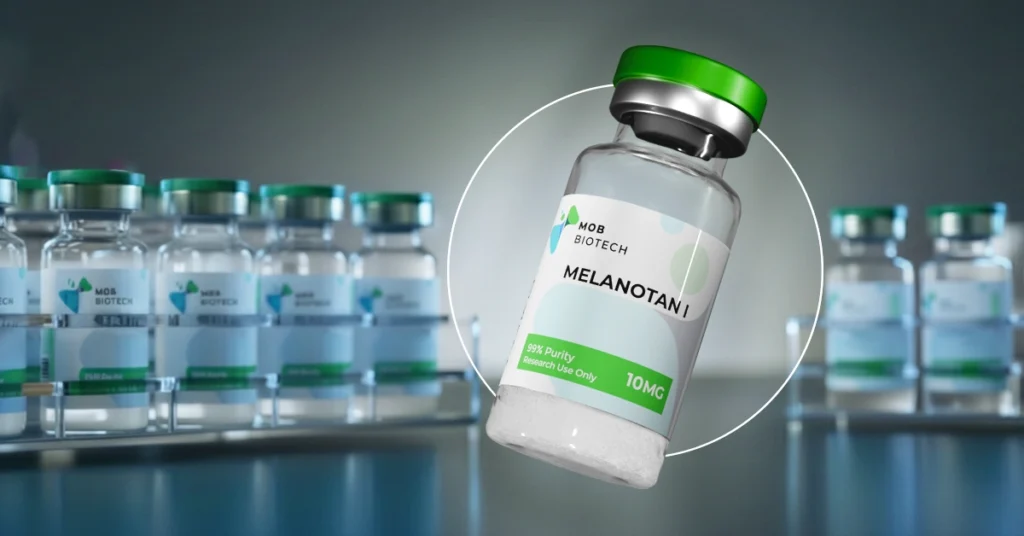In the ever-evolving landscape of peptide research, you understand that certain compounds refuse to be dismissed, consistently re-emerging and proving their enduring value and profound, multifaceted potential. Melanotan I (afamelanotide) is exactly that peptide—a powerful name whispered among experienced researchers as a foundational staple, yet often overlooked by those who haven’t spent the necessary time delving deep enough into its compelling mechanisms. So, if your advanced protocols aren’t already exploring the complete breadth of what Melanotan I genuinely offers, you might be missing out on a critical, highly-targeted tool that top-tier laboratories are leveraging right now to understand systemic resilience. Because this is the core truth: Melanotan I stands as a profound testament to targeted biomimicry, functioning as a synthetic analog of the naturally occurring alpha-melanocyte-stimulating hormone (α-MSH). This endogenous tridecapeptide plays a pivotal role in a vast array of physiological functions that extend well beyond its most recognized influence on pigmentation. Savvy researchers see that Melanotan I’s utility extends far past the superficial, cleanly tapping into fundamental cellular and systemic pathways that hold immense promise for deeper mechanistic understanding.
What Is Melanotan I?
Melanotan I is a linear peptide consisting of 13 amino acids, meticulously engineered to mimic the core functional sequence of α-MSH. It belongs to the melanocortin peptide family, specifically acting as a potent agonist primarily at the Melanocortin 1 Receptor (MC1R). While its name often conjures images related to pigment, its scientific significance stems from its selective and powerful interaction with the melanocortin system, a complex network of receptors and ligands that regulate diverse biological processes.
This peptide fragment’s interaction with MC1R is critical, as this receptor is widely expressed across various tissues, including melanocytes, immune cells, and even components of the central nervous system. Melanotan I’s ability to selectively activate MC1R allows researchers to investigate its intricate downstream signaling cascades, which are far more complex and far-reaching than a simple color change. Its multi-pathway potential makes it a fascinating subject for investigating cellular protection, anti-inflammatory responses, and even aspects of systemic regulation.
What Research Models Are Exploring with Melanotan I?
The versatility of Melanotan I makes it a subject of extensive inquiry across numerous research models. Laboratories are actively investigating its potential in areas that extend well beyond its historical associations. Some of the most common study areas include:
✅ Melanogenesis Regulation: Investigating the stimulation of melanin production via MC1R activation, a classic area of study for understanding cellular protective mechanisms against various stressors.
✅ Inflammatory Pathway Modulation: Exploring its anti-inflammatory properties, particularly in models where MC1R activation can temper cytokine release and cellular stress responses.
✅ Cellular Protection Mechanisms: Research into its role in protecting cells and tissues from oxidative damage and other forms of cellular insult, often linked to its broad immunomodulatory effects.
✅ Barrier Function and Integrity: Exploring its potential influence on epithelial and dermal barrier functions, given the presence of MC1R in these tissues.
✅ Photoprotective Strategies: Investigating its capacity to enhance endogenous protective responses against UV radiation and other environmental stressors in various cell lines and tissue models.
These diverse research avenues highlight Melanotan I’s relevance in understanding complex biological systems, from fundamental cellular responses to broader systemic interactions. Researchers are meticulously mapping its influence on receptor activity, gene expression, and downstream signaling, consistently uncovering new layers of its mechanistic impact.
Why Top Researchers Include It in Their Protocols
The consistent reorder rates for Melanotan I among high-volume research laboratories aren’t a coincidence. They are a clear indicator that serious researchers view this peptide as an indispensable tool. While some compounds flicker into popularity and fade, Melanotan I is a workhorse that quietly underpins significant discoveries. The most effective researchers don’t just know about Melanotan I; they’ve integrated it into their core protocols, relying on its consistent activity and well-characterized mechanisms to push the boundaries of their investigations.
Leading principal investigators understand that reliable reagents are the bedrock of reproducible science. Melanotan I offers a well-defined interaction with the melanocortin system, providing a stable platform for exploring complex physiological questions. Its consistent performance makes it a go-to for establishing foundational data and building sophisticated experimental models. Overlooking Melanotan I means potentially missing out on the foundational insights that many of your peers are already leveraging.
What to Look for When Ordering Melanotan I
In the pursuit of robust and reliable research, the quality of your reagents is paramount. When sourcing Melanotan I, discerning researchers prioritize several key factors to ensure the integrity of their studies:
- Certificate of Analysis (CoA) Verification: Always demand a comprehensive CoA that confirms the identity, purity, and concentration of the peptide. This document is your assurance of what’s in the vial.
- HPLC and Mass Spec Testing: High-Performance Liquid Chromatography (HPLC) and Mass Spectrometry (Mass Spec) data are non-negotiable. These advanced analytical techniques provide definitive proof of purity and molecular weight, validating the peptide’s structural integrity.
- US-Based Shipping: Sourcing from US-based suppliers ensures faster delivery, reduces logistical complexities, and often indicates adherence to stricter quality control standards.
- Transparent Sourcing: Reputable suppliers are open about their manufacturing processes and raw material sourcing, giving you confidence in the peptide’s origin and synthesis.
- Rewards Program and Account Tools: While not directly related to peptide quality, features like rewards programs and robust account management tools signify a supplier committed to long-term customer relationships and operational excellence, reflecting an overall dedication to service.
MOB Biotech stands as a reliable option for these critical quality assurances. We understand that your research demands nothing less than the best, and our commitment to transparent, rigorously tested products reflects that understanding.
Why Some Labs Still Overlook It (and Why That’s a Mistake)
We’re not here to convince everyone. Our mission is to equip serious researchers with the tools they need for groundbreaking work. However, it’s worth acknowledging that some labs, perhaps focused on newer, flashier compounds, still overlook the foundational utility of Melanotan I. This oversight, though understandable in a fast-paced field, can be a significant mistake.
By not incorporating Melanotan I into their investigative repertoire, researchers may be missing out on critical insights into fundamental melanocortin pathways that underpin a vast array of physiological processes. They risk falling behind peers who are actively using it to explore nuances in cellular signaling, inflammatory cascades, and protective mechanisms. The fear of loss here is tangible: the loss of competitive edge, the loss of novel discoveries, and the loss of a proven, versatile tool that continues to yield valuable data in serious research settings. Don’t let your lab be the one that discovers these pathways later than necessary.
Where Melanotan I Fits in the Research Landscape
Melanotan I’s broad interaction with the melanocortin system positions it as a highly versatile research tool, fitting into multiple application areas:
📌 Metabolic Modulation: Investigations into its potential indirect roles in energy homeostasis and glucose metabolism, given the systemic reach of the melanocortin system.
📌 Cellular Protection: Exploring its ability to mitigate cellular damage and enhance resilience in various in vitro and in vivo models.
📌 Tissue Repair: Research into its influence on healing processes and tissue regeneration, often linked to its anti-inflammatory and protective effects.
📌 Neurological Pathways: Studies on its lesser-explored interactions within the central nervous system, where melanocortin receptors are also present, influencing neuroprotection and inflammation.
📌 Anti-inflammatory Mechanisms: A core area of study, leveraging its ability to dampen pro-inflammatory responses and promote homeostatic balance.
Melanotan I is often paired with other peptides, such as BPC-157, for deeper recovery and tissue repair models, offering researchers a synergistic approach to complex biological questions.
Final Word on Melanotan I
Melanotan I is far more than its initial characterization suggests. It remains a powerful, relevant, and consistently valuable tool for understanding the intricate workings of the melanocortin system and its expansive influence on cellular and systemic physiology. Don’t let your research miss out on the profound insights this peptide continues to offer.
Explore batch-tested Melanotan I at MOB Biotech.
🧬 US-Based. CoA-Backed. Rewards on every purchase.
👉 Explore Melanotan I at MOB Biotech

